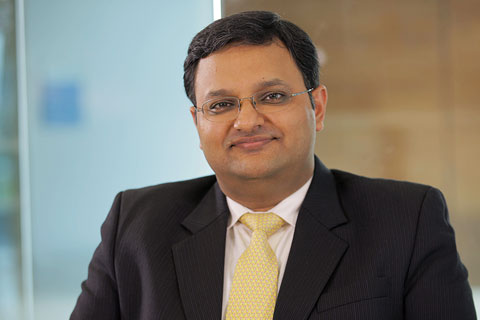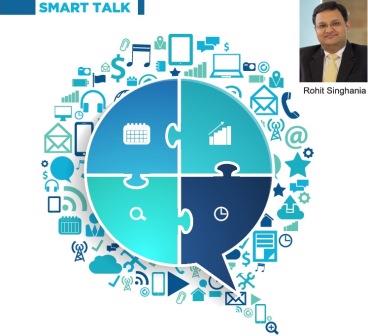 Rohit Singhania is the Co-Head Equities, DSP Mutual Fund. He is the Fund Manager for the DSP India T.I.G.E.R fund (The Infrastructure Growth and Economic Reforms Fund), the DSP Opportunities Fund and the DSP Tax Saver Fund. He is also the co-fund manager of the DSP Natural Resources and New Energy Fund.
Rohit Singhania is the Co-Head Equities, DSP Mutual Fund. He is the Fund Manager for the DSP India T.I.G.E.R fund (The Infrastructure Growth and Economic Reforms Fund), the DSP Opportunities Fund and the DSP Tax Saver Fund. He is also the co-fund manager of the DSP Natural Resources and New Energy Fund.
In this exclusive interview with Geojit Insights he talks about the funds he manages, outlook on pharma, healthcare, infrastructure and energy sector, and about markets in general.
While analysing your funds we noticed that you have given a higher weightage to large cap stocks in your portfolio though you had enough room to accommodate quality mid and small caps. Is it a part of your portfolio strategy or to maintain consistency? Do you have plans to increase your mid and small exposure looking at improving market sentiments?
All our funds are run according to their mandate / investment objective. The DSP Equity Opportunities fund for example falls under the SEBI category of “Large and Mid-Cap”. This requires the fund to have at least 35% each in the large cap and mid cap categories respectively. Currently we own ~38% in the small and mid-cap portion of this fund.
That said, we are very bottom-up focused – so if I find a good small cap stock idea, I will add it even if it means I may go a little higher than my historical range of allocations to small caps.
Your equity opportunities fund holds a big portfolio of 80 stocks. What are the strategies you adopt while selecting a stock into your portfolio and exiting from a stock?
We currently own 66 stocks in the DSP Equity Opportunities Fund. For us, the focus is purely individual bottom up stock selection. We look at buying companies that exhibit healthy cash flows, earnings growth, high RoEs and RoCEs, robust business model among other fundamental parameters. Triggers for entering, adding, exiting or trimming our stocks include price targets, stock recommendations and upsides/downsides we maintain for the stocks under our coverage.
What is your long term outlook on the energy sector, with respect to the changing crude oil prices? What is your opinion on the medium term prospects of growing alternate energy demand in the Indian context?
We believe, predicting crude oil prices is not our forte. However our investments in the energy sector are a mix of downstream and upstream where the spread / margin is more critical rather than the absolute oil price itself. While this may not have been the case many years ago, in June 2017, the government brought in daily fuel price deregulation which reduced the subsidy burden on companies in the sector. In terms of alternative energy demand, India has 14 of 15 most polluted cities in the world and autos cause almost 40% of this pollution. Hence movement away from fossil fuels with support from the Indian govt. is bound to happen in due course.
Recently mid and small cap stocks bounced back from a one year down side movement. What is your outlook on the mid cap and small cap stocks from a medium term perspective?
We track valuations of the mid and small cap companies (on a price/book basis) versus large cap companies. We believe that despite the correction last year, valuations remain above average to the tune of ~15% and 25% for mid caps and small caps respectively.
What are the macro and the micro economic factors which you follow as a part of your stock picking strategy?
We are largely bottom-up driven so our focus is on micro factors rather than macro. Some of the factors we look at include earnings growth, RoE, operating cash flows, free cash flows, market share trends, new product launches, margin profiles, competitive intensity, working capital, and leverage among others.
Mutual funds are still holding significant exposure in NBFC stocks in their portfolio. In your funds the current NBFC allocation is 8.23% .What are the major challenges for the sector going forward?
We see the NBFC liquidity situation normalizing, compared to the crisis that emerged in October 2018. Our focus has been on companies with strong parentage, as we believe these have been able to address any liquidity needs. Companies with high exposure to real-estate remain weak links; Credit spreads have started to moderate from October 2018 peaks but are still above average. For instance, AAA Corporate 3Y spreads increased from 80 bps, peaked to 140-150 bps and is now around 100 bps. We have significantly reduced our NBFC exposure.
You have kept a considerable allocation towards pharma and healthcare. Where do you see Indian pharma 10 years down the line?
We remain constructive on the Indian pharma sector, both from an India demand perspective (large scope for growth in healthcare spends), and the export opportunity (US FDA issues to normalize).
What are the key issues / challenges faced by Indian infrastructure growth and your expectations from interim budget proposals to revive the sector? What latest economic reforms are the TIGER fund planning to capitalise on?
The infrastructure spend over the last few years has been led by the government rather than the private sector. However, we believe this is mainly due to subdued capacity utilization for the private sector (led by lack of demand). The GFCF (Gross Fixed Capital Formation) as a % of GDP declined from 34% of GDP in FY17 to a bottom 28% of GDP in FY17, and is now at ~29%. Around 60% of this decline can be explained by the housing market slowdown. The TIGER fund aims to capitalize on a variety of reforms including Goods & Services Tax (unorganized to organized shift), Insolvency & Bankruptcy Code (corporate banks recovering NPAs), revival in Infrastructure spend in the next few years, Ease of Doing Business rank improvement (road sector benefiting from easier land acquisition), Make in India (manufacturing sector), fuel price deregulation (OMCs), UDAY reforms (power companies), bank recapitalization (PSU banks) etc.
As the next parliament election is a few months away, what strategy should a common investor adopt?
We think elections are just a transitory event, and long-term returns are not correlated to election outcomes. An investor participating in the long-term equity story of various companies should not be worried about election results as we believe the underlying inspirational story of end consumers will not change. For example, irrespective of the party in power, we expect consumers will still aspire to buy Air conditioners, 2 wheelers, cars, electronics, build houses and so on, which will continue to boost the top line and bottom line of companies. So our suggestion would be for investors to invest in line with their asset allocations.
Chinese product invasion and swiftly changing face of technology across the globe are posing challenges to Indian industry severely. What are the challenges that Indian Inc. face in terms of ensuring continued FII flows in coming years? How should those challenges be met?
Global growth in the future is expected to be driven largely by countries such as China and India, and hence ignoring India will be a difficult call for any investor. Also, many Indian companies are world-class institutions, have top quality management teams and have capital efficiency ratios amongst the best in the world. The most recent ease of doing business survey by the World Bank ranks India on Protecting Minority Investors as rank 7 out of 190, which is a testament to India’s shareholder rights, governance safeguards and corporate transparency requirements – these are all positives for any foreign investor to consider allocation to India.










